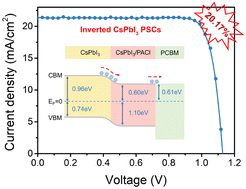Surface n-type band bending for stable inverted CsPbI3 perovskite solar cells with over 20% efficiency†
Abstract
Inverted CsPbI3 perovskite solar cells offer merits for tandem and indoor photovoltaics. Compared to the regular structure (n–i–p), realizing high-efficiency inverted devices is still challenging due to severe energy losses at the contact of the p-type perovskite and n-type electron transporting layer (ETL). Herein, we develop a surface n-type band bending strategy to mitigate such energy loss. It is discovered that the post-deposition of propylamine hydrochloride induces a p to n-type transition at the CsPbI3 surface to accelerate the separation and extraction of the electrons while passivating the surface defects. Consequently, the power conversion efficiency (PCE) of inverted CsPbI3 devices reaches record-high values of 20.17% (19.67% on average) under 1-sun equivalent illumination and 38.93% under indoor LED light (1000 lux, 307 μW cm−2). Moreover, such inverted devices maintain ∼97% PCE after light soaking for 792 h at the open circuit condition while the control samples degrade to ∼11% in 552 h.



 Please wait while we load your content...
Please wait while we load your content...